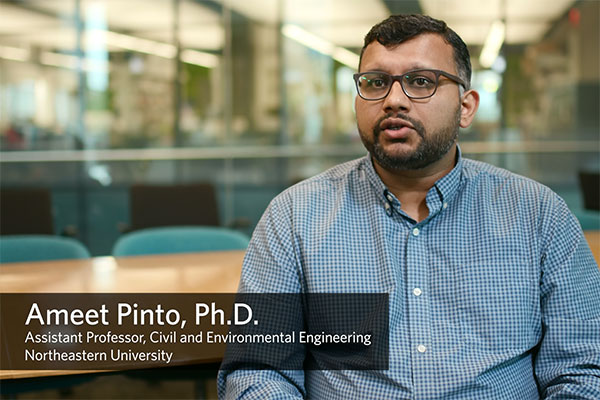Ameet Pinto Receives 2019 Paul L. Busch Award from the Water Research Foundation

Microbial communities and their activities are consequential for the health of the environment and humans. Assistant Professor Ameet Pinto, civil and environmental engineering, researches microorganisms in the engineered water cycle, including drinking water and wastewater systems, and its interface with the environment and public health. His research group works on understanding how microbial communities are influenced by treatment processes and how they in turn impact process performance and what can be done to manage these communities more reliably and more efficiently. Recently, Pinto was recognized with the prestigious 2019 Paul L. Bush Award from the Water Research Foundation for his research.
Supported by the Paul L Busch Award, he is developing a low-cost platform for real-time microbial community analyses. A combination of machine learning approaches trained using microscopic images paired with DNA sequencing data may allow for image-only based predictions of microbial community in a sample. To do this, he is using a combination of two portable technologies—a low-cost microscope and nanopore sequencing.
Leveraging recent advances in miniaturized microscopy, his research group has been developing a device that can achieve micron level resolution to distinguish microbes from other particles without any fluorescent dyes or stains. Further, the use of light scattering properties of imaged microbes of different wavelengths and incidence angle may allow their group to move from simply counting microbes towards identifying them.
Just like microscopes have become smaller and cheaper, so have DNA sequencing instruments. His research group is working with the MinION sequencer, a handheld DNA device developed by Oxford Nanopore Technologies that provides sequencing data in real-time. A key challenge is making it work for different sample matrices, from wastewater to drinking water, while keeping the price point low. The overall goal is to develop methods to capture target genes from extracted DNA and then concentrate them quickly so they can be sequenced on the MinION device without the need for PCR amplification.
This image-only based estimation for microbial community is likely to work on a system by system basis, but the fact that the two enabling technologies that supply the data do not require significant capital investment means that the platform can remain affordable to every water utility.
Getting state-of-the-art technology in the hands of every operator and in every water utility—irrespective of size of their customer base—will radically change how biology is managed and has the potential to bring many more water professionals into the business of innovation in the water sector.